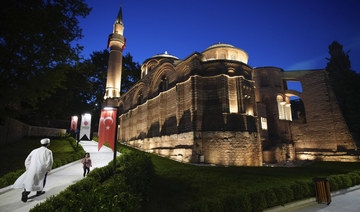WASHINGTON: In his US Capitol office, Rep. Jason Crow keeps several war mementos. Sitting on a shelf are his military identification tags, the tailfins of a spent mortar and a piece of shrapnel stopped by his body armor.
Two decades ago, Crow was a 24-year-old platoon leader in the American invasion of Iraq. Platoon members carried gas masks and gear to wear over their uniforms to protect them from the chemical weapons the US believed — wrongly — that Iraqi forces might use against them.
Today, Crow sits on committees that oversee the US military and intelligence agencies. The mistakes of Iraq are still fresh in his mind.
“It’s not hyperbole to say that it was a life-changing experience and a life frame through which I view a lot of my work,” the Colorado Democrat said.
The failures of the Iraq w ar deeply shaped American spy agencies and a generation of intelligence officers and lawmakers. They helped drive a major reorganization of the US intelligence community, with the CIA losing its oversight role over other spy agencies, and reforms intended to allow analysts to better evaluate sources and challenge conclusions for possible bias.
But the ultimately incorrect assertions about Iraq’s nuclear, biological and chemical weapons programs, repeatedly cited to build support for the war in America and abroad, did lasting damage to the credibility of US intelligence.
As many as 300,000 civilians died in two decades of conflict in Iraq, according to Brown University estimates. The US lost 4,500 troops and spent an estimated $2 trillion on the Iraq War and the ensuing campaign in both Iraq and Syria against the extremist Daesh group, which took hold in both countries after the US initially withdrew in 2011.
Those assertions also made “weapons of mass destruction” a catchphrase that’s still used by rivals and allies alike, including before the Russian invasion of Ukraine, which US intelligence correctly forecast.
Avril Haines, the current US director of national intelligence, noted in a statement that the intelligence community had adopted new standards for analysis and oversight.
Only 18 percent of US adults say they have a great deal of confidence in the government’s intelligence agencies, according to a new poll from The Associated Press-NORC Center for Public Affairs Research. Forty-nine percent say they have “some” confidence and 31 percent have hardly any confidence.
Shortly after the Sept. 11, 2001, terrorist attacks, President George W. Bush ordered an invasion of Afghanistan, where the ruling Taliban sheltered Al-Qaeda leader Osama bin Laden and allowed the group to run training camps.
Bush’s administration soon began to warn about Iraq, which was long seen as threatening American interests in the Middle East.
Iraq was known to have sought a nuclear weapon in the 1980s and had chemical and biological weapons programs by the end of the Gulf war in 1991. It had been accused of concealing details about those programs from international inspectors, before they were kicked out in 1998.
The Bush administration argued Saddam Hussein’s government was still hiding programs from inspectors after they reentered the country in 2002 and found no signs of resumed production.
A US intelligence estimate published in October 2002 alleges that Iraq had considered buying uranium from Niger and aluminum tubes for centrifuges, that it was building mobile weapons labs, that it was considering using drones to spread deadly toxins, and that it had chemical weapons stockpiles of up to 500 tons.
Some US officials also suggested Iraqi officials had ties to Al-Qaeda leaders despite evidence of deep antipathy between the two sides.
Those claims would largely be debunked within months of the invasion. No stockpiles were found. Subsequent reviews have blamed those claims on outdated information, mistaken assumptions, and a mix of uninformed sources and outright fabricators.
Bush repeated wrong US intelligence findings before the war, as did Secretary of State Colin Powell in a landmark February 2002 speech before the UN.



























